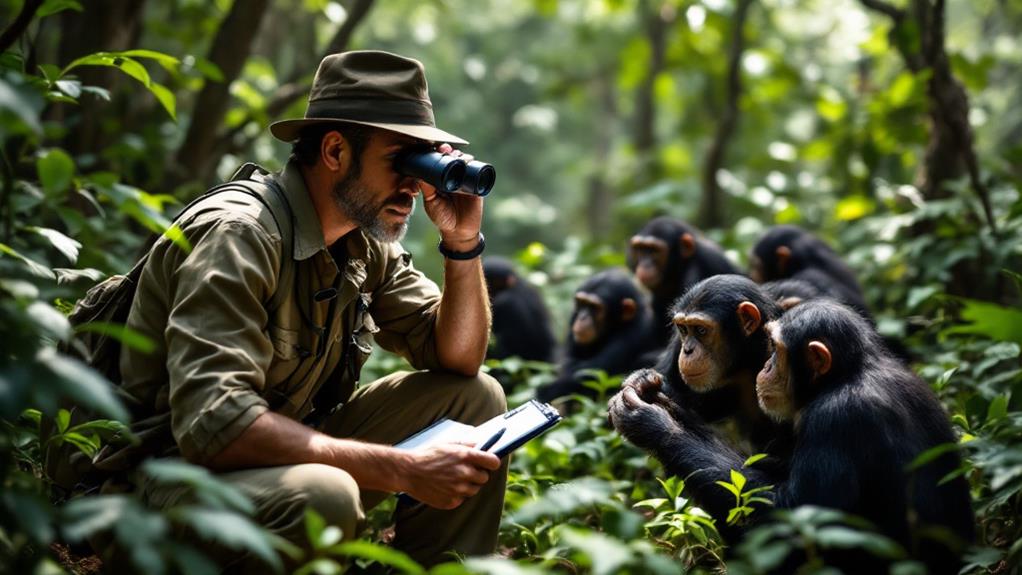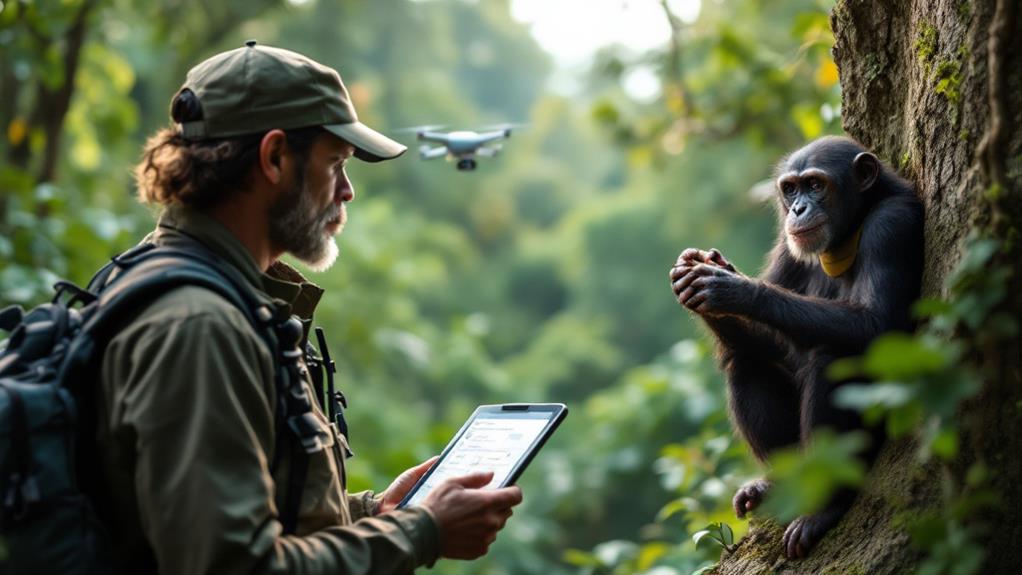When observing primate behavior, you'll employ various techniques to gather thorough data. Scan sampling helps you efficiently collect information on multiple individuals, while focal animal sampling allows for detailed observations of a single subject. Ad libitum observations capture rare or unexpected behaviors. You'll use ethograms to catalog and code distinct behaviors systematically. Time-activity budgets and social network analysis provide insights into daily patterns and group dynamics. Modern technology, like GPS tracking and remote sensing, enhances data collection capabilities. Remember to prioritize field safety and ethical considerations throughout your research. Exploring these methods further will equip you with a robust toolkit for primate behavior studies.
Scan Sampling Methods

When observing primate behavior, scan sampling is a widely used technique that allows researchers to efficiently collect data on multiple individuals or groups. You'll find this method particularly useful when studying large populations or when you need to gather information on overall group dynamics.
To perform scan sampling, you'll need to define specific time intervals at which you'll "scan" the entire group. These intervals can range from a few minutes to several hours, depending on your research goals. At each predetermined time point, you'll quickly record the behavior of each visible individual in the group.
You'll want to create a clear coding system for behaviors before starting your observations. This system should include easily recognizable and mutually exclusive categories, such as feeding, grooming, resting, or locomotion. As you scan the group, you'll assign each individual to one of these categories based on their current activity.
It's important to maintain consistency in your sampling method. Always scan in the same direction and at the same pace to avoid biasing your results. You should also decide beforehand how to handle individuals that are out of sight or engaged in ambiguous behaviors.
Scan sampling is particularly effective for capturing time-budget data, showing how primates allocate their time across different activities. You can use this information to compare behavior patterns between different groups, seasons, or environmental conditions.
While scan sampling provides a thorough overview of group behavior, it may not capture rare or brief events. Consider combining this technique with other methods, such as focal animal sampling, to gain a more extensive understanding of primate behavior.
Focal Animal Sampling
In contrast to scan sampling, focal animal sampling zeroes in on a single individual for a specified duration. This method allows you to gather detailed information about a particular primate's behavior over time. You'll choose one animal and observe it continuously, recording all its activities and interactions.
To begin focal sampling, you'll need to select your subject carefully. Choose an individual that's easily identifiable and representative of the group you're studying. Decide on an appropriate observation period, typically ranging from 10 minutes to several hours, depending on your research goals.
During the observation, you'll record all occurrences of predetermined behaviors. These might include feeding, grooming, locomotion, vocalizations, and social interactions. You'll note the frequency, duration, and context of each behavior. It's essential to maintain focus on your chosen subject, even if other interesting events occur nearby.
You'll also want to record any relevant environmental factors that may influence the animal's behavior, such as weather conditions, food availability, or the presence of predators. This contextual information will help you interpret your data more accurately.
Focal animal sampling is particularly useful for studying rare behaviors, individual differences, and fine-grained behavioral sequences. It provides a more thorough picture of an individual's time budget and social relationships than scan sampling.
However, this method has limitations. It's time-consuming and may not capture group-level patterns as effectively as other techniques. Additionally, your chosen subject might not be representative of the entire population. To mitigate these issues, you should rotate focal subjects and combine this method with other observation techniques for a more balanced research approach.
Ad Libitum Observations

Have you ever witnessed a rare or unexpected behavior during primate observation? Ad libitum observations are perfect for capturing these unique moments. This method allows you to record any behavior of interest as it occurs, without following a predetermined sampling schedule or focusing on specific individuals.
Ad libitum sampling is particularly useful when you're studying infrequent or unpredictable behaviors, such as aggression, mating, or tool use. It's also valuable for documenting social interactions, especially in species with complex social structures. You'll find this technique helpful when you're exploring a new research area or generating hypotheses for future studies.
To conduct ad libitum observations, you'll need to remain alert and ready to record at all times. Keep your notebook or recording device handy, and jot down detailed notes about the behavior, the individuals involved, and the context in which it occurs. Don't forget to note the time and location of each observation.
While ad libitum sampling provides valuable qualitative data, it has limitations. It's prone to observer bias, as you're more likely to notice and record behaviors that interest you or stand out. Additionally, it doesn't provide a systematic representation of all behaviors or individuals in a group.
To maximize the benefits of ad libitum observations, combine them with other sampling methods like focal animal sampling or scan sampling. This approach will give you a more thorough understanding of primate behavior patterns. Remember to clearly differentiate between data collected through ad libitum observations and those gathered using more structured methods when analyzing and reporting your findings.
Time-Activity Budgets
While ad libitum observations capture unique moments, time-activity budgets offer a systematic approach to understanding how primates allocate their time. You'll find this method invaluable for quantifying the daily activities of your study subjects. To create a time-activity budget, you'll need to use interval sampling techniques.
Start by defining categories of behavior you want to track, such as feeding, resting, traveling, and social interactions. Next, decide on an appropriate time interval for your observations, typically ranging from 1 to 15 minutes. During each interval, you'll record the predominant activity of your focal animal or group.
You'll need to maintain consistent observation periods, often spanning entire days or specific time blocks, to capture a representative sample of the primates' activities. It's essential to collect data across different seasons and times of day to account for variations in behavior patterns.
As you gather data, you'll calculate the proportion of time spent on each activity. This information allows you to create detailed breakdowns of how primates allocate their time and energy. You can use these budgets to compare activity patterns between individuals, groups, or species, as well as to assess the impacts of environmental factors on behavior.
Time-activity budgets are particularly useful for understanding primate ecology and conservation. They can reveal how habitat changes or human disturbances affect primate behavior, helping you develop targeted conservation strategies. Additionally, you can use these budgets to identify vital resources and habitats that primates rely on throughout their daily and seasonal cycles.
Social Network Analysis

As you explore deeper into primate behavior, you'll find that social network analysis offers a powerful tool for understanding group dynamics. This method allows you to map out relationships and interactions within a primate group, revealing complex social structures that might otherwise remain hidden.
To conduct a social network analysis, you'll need to collect data on individual interactions. You'll observe and record who interacts with whom, the frequency of these interactions, and their nature (e.g., grooming, aggression, or play). It's essential to identify each individual primate accurately, often using distinguishing features or tags.
Once you've gathered sufficient data, you'll create a sociogram – a visual representation of the group's social network. In this diagram, each primate is represented by a node, with lines connecting individuals who interact. The thickness of these lines can indicate the strength or frequency of the relationship.
You'll then analyze this network using various metrics. Centrality measures can reveal which individuals are most influential or well-connected within the group. Clustering coefficients can show how tightly knit subgroups are within the larger community. By examining these patterns, you can gain insights into the group's social hierarchy, alliances, and information flow.
Social network analysis can help you answer important questions about primate behavior. You might investigate how diseases spread through a population, how social bonds affect mating strategies, or how leadership emerges within a group. This technique also allows you to track changes in social dynamics over time, providing valuable data on how primate societies evolve and adapt.
Ethograms and Behavior Coding
Moving from the broader view of social networks, we now focus on a fundamental tool in primate behavior research: ethograms and behavior coding. Ethograms are thorough catalogs of all behaviors exhibited by a species or group of animals. They're vital for standardizing observations and guaranteeing consistent data collection across different researchers and studies.
To create an ethogram, you'll need to spend extensive time observing the primates, documenting every distinct behavior you see. You'll assign each behavior a clear, concise name and provide a detailed description. This process helps you develop a deep understanding of the species' behavioral repertoire.
Once you've compiled your ethogram, you'll use it for behavior coding during observations. You'll record the occurrence, frequency, duration, and context of each behavior listed in the ethogram. This systematic approach allows for quantitative analysis of primate behavior patterns.
When coding behaviors, you'll often use sampling techniques like focal animal sampling or scan sampling. In focal animal sampling, you'll observe one individual for a set period, recording all its behaviors. Scan sampling involves quickly scanning the entire group at regular intervals, noting each individual's behavior.
It's vital to maintain consistency in your coding. You'll need to train yourself and other observers to recognize and categorize behaviors uniformly. Regular inter-observer reliability checks will help guarantee the accuracy of your data.
Technology in Primate Research

In light of rapid technological advancements, primate research has been revolutionized. You'll find that modern technology has greatly enhanced the accuracy, efficiency, and scope of primate behavior observations. GPS tracking devices, for instance, allow you to monitor primate movements over vast areas and extended periods, providing invaluable data on ranging patterns and habitat use.
High-definition cameras and remote sensing technologies have transformed data collection methods. You can now capture detailed footage of primate behavior without disturbing their natural activities. Drones equipped with thermal imaging cameras enable you to observe nocturnal species or those in dense forest canopies that were previously challenging to study.
Artificial intelligence and machine learning algorithms have streamlined data analysis. You can process large volumes of video footage or audio recordings much faster, identifying specific behaviors or vocalizations with greater accuracy than manual coding.
Wearable sensors and biologging devices offer insights into primate physiology and behavior. You can monitor heart rate, body temperature, and even brain activity in free-ranging primates, correlating these data with observed behaviors and environmental factors.
3D modeling and virtual reality technologies allow you to recreate primate habitats and simulate various scenarios. This enables you to study primate responses to environmental changes or potential conservation interventions without disturbing actual populations.
Lastly, cloud-based data storage and sharing platforms have facilitated collaboration among researchers worldwide. You can now easily access and analyze data from multiple study sites, enhancing the scope and reproducibility of primate research.
Field Safety and Ethics
Guaranteeing field safety and adhering to ethical guidelines are paramount when conducting primate behavior observations. You must prioritize your safety and that of your research team while minimizing disturbance to the primates and their habitat. Always work in pairs or groups, and maintain constant communication with your base camp.
Before entering the field, you'll need to undergo proper training in wilderness survival, first aid, and local hazard awareness. Familiarize yourself with the terrain, climate, and potential dangers such as venomous animals or unstable ground. Carry essential safety equipment, including a first aid kit, GPS device, and emergency communication tools.
You must obtain all necessary permits and approvals from local authorities and ethics committees before beginning your research. Respect the primates' natural behaviors and habitat by maintaining a safe distance and avoiding interference. Use non-invasive observation techniques whenever possible, and limit the use of tracking devices or other equipment that may cause stress to the animals.
Be mindful of the potential impact your presence may have on the primate population and surrounding ecosystem. Minimize your environmental footprint by properly disposing of waste and avoiding the introduction of non-native species or pathogens.
Engage with local communities and involve them in your research when appropriate. Share your findings with them and acknowledge their contribution to your work. This fosters positive relationships and promotes conservation efforts.
Lastly, guarantee that your data collection and analysis methods are transparent and reproducible. Maintain detailed records of your observations and adhere to ethical guidelines for publishing and sharing your research findings.
Data Analysis Techniques

After collecting your observational data, you'll need to employ various data analysis techniques to extract meaningful insights from your primate behavior studies. Start by organizing your raw data into a structured format, such as spreadsheets or databases, to facilitate easier analysis. You'll want to categorize behaviors, record frequencies, and note any contextual information that might be relevant.
Quantitative analysis techniques are essential for identifying patterns and trends. Calculate basic descriptive statistics, including means, medians, and standard deviations, to summarize your data. You can use statistical software to perform more advanced analyses, such as chi-square tests for association between variables or t-tests to compare group differences.
For temporal data, you'll find time series analysis useful. Look for patterns in behavior over time, such as daily or seasonal variations. You might also employ sequential analysis to examine the order and timing of specific behaviors.
Qualitative analysis is equally important. Use coding techniques to categorize and interpret complex behaviors or social interactions. You can create ethograms to visually represent behavioral repertoires and their frequencies.
Don't forget to analyze your data in the context of your research questions. Use hypothesis testing to evaluate your predictions and draw conclusions about primate behavior. You'll also want to contemplate any potential confounding variables that might affect your results.

Erzsebet Frey (Eli Frey) is an ecologist and online entrepreneur with a Master of Science in Ecology from the University of Belgrade. Originally from Serbia, she has lived in Sri Lanka since 2017. Eli has worked internationally in countries like Oman, Brazil, Germany, and Sri Lanka. In 2018, she expanded into SEO and blogging, completing courses from UC Davis and Edinburgh. Eli has founded multiple websites focused on biology, ecology, environmental science, sustainable and simple living, and outdoor activities. She enjoys creating nature and simple living videos on YouTube and participates in speleology, diving, and hiking.

